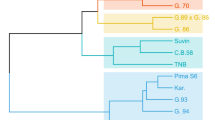Abstract
In Tanzania, cotton is of great economical importance, representing a large percentage of agricultural exports, but yield and lint quality is still relatively poor. The aim of this study was to identify parents to improve boll and lint yield and quality. Parents and F1 progeny of a 7 × 7 diallel were evaluated in four different environments. Results indicated significant variation for especially yield components, yield, ginning outturn and fibre quality. Parents with high and positive GCA like NTA 93-21, Delcot 344, Auburn 56 and MZ561 and combinations with high and positive SCA for the characteristics were identified. Additive genetic effects were seen for most of the characteristics, except for fibre strength at one locality. Parents with high GCA effects for certain characteristics produced combinations with high SCA effects for the same characteristics. This study indicated that there is enough genetic variability for boll and lint yield and quality for effective selection, and good parents that can be included in the breeding programme.
Similar content being viewed by others
References
Agrobase (2000) Agronomix Software Inc., 71 Waterloo st., Winnipeg, Manitoba, R3NOS4, Canada
Alam AKMR, Roy NC, Islam H (1992) Heterosis and combining ability in upland cotton (Gossypium hirsutum). Ann Bangladesh Agric 2:31–39
Ashraf M, Ahmad S (2000) Genetic effects for yield components and fibre characteristics in upland cotton (Gossypium. hirsutum L.) cultivated under salinized (NaCl) conditions. Agronomie 20:917–926
Baffes J (2002) Tanzania’s Cotton Sector. Constraints and Challenges in a Global Environment. Africa Region Working Paper Series No. 42
Coyle GG, Smith CW (1997) Combining ability for within-boll yield components in cotton (Gossypium hirsutum L.). Crop Sci 37:1118–1122
Dabholkar AR (1992) Elements of biometrical genetics. Concept Publication Camp, New Delhi, India
Echekwu CA, Alaba SO (1995) Genetic effects of yield and its components in interspecific crosses of cotton. Discov Innov 7:395–399
El-Adl AM, Miller PA (1971) Transgressive segregation and the nature of the gene action for yield in an intervarietal cross of upland cotton. Crop Sci 11:381–384
El-Dahan MAA, Leid EO, Lopez M, Gutierrez JC (2003) Combining ability of yield and yield components in upland cotton (Gossypium hirsutum L.) under drought stress conditions. In: Proceedings world cotton research conference. Cape Town, South Africa, pp 43–48
Griffing B (1956) Concept of general and specific combining ability in relation to diallel crossing systems. Aust J Biol Sci 9:463–493
Hayman BI (1954) The theory and analysis of diallel crosses. Genetics 45:155–172
Kumar LS (1999) DNA markers in plant improvement. An overview. Biotechnol Adv 17:143–182
Lukonge E, Ramadhani OS (1999) Review of plant breeding and agrobiodiversity in the Lake Zone. In: Breeding and agrobiodiversity workshop proceedings. Agricultural Research and Development Ukiriguru, Mwanza, Tanzania, pp 6–11
Machado CF, Santos JB, Nunes GH, Ramalho MAP (2002) Choice of common bean parents based on combining ability estimates. Genet Mole Biol 25:179–183
Meredith WR Jr (1984) Quantitative inheritance. In: Kohel RJ, Lewis CF (eds) Cotton. Agronomic Monographs. ASA, CSSA, SSSA, South Segoe, Madison, WI, pp 131–150
Meredith WR Jr, Brown JS (1998) Heterosis and combining ability of cottons originating from different regions of the United States. J Cotton Sci 2:77–84
Murtaza N, Kitaoka M, Ali GM (2005) Genetic differentiation of cotton cultivars by polyacrylamide gel electrophoresis. J Central Eur Agric 6:69–76
Singh H (2002) Genetic architecture of yield and its associated traits in bread wheat. PhD Thesis, Rajasthan Agriculture University. Bikaner, Rajasthan, India
Tang B, Jenkins JN, McCarty JC, Watson CE (1993) F2 hybrids of host plant germplasm and cotton cultivars: heterosis and combining ability for fiber qualities. Crop Sci 33:706–710
Thomson NJ, Luckett DJ (1988) Heterosis and combining ability effects on cotton. 1 Combining ability. Aust J Agric Res 39:973–990
Author information
Authors and Affiliations
Corresponding author
Rights and permissions
About this article
Cite this article
Lukonge, E.P., Labuschagne, M.T. & Herselman, L. Combining ability for yield and fibre characteristics in Tanzanian cotton germplasm. Euphytica 161, 383–389 (2008). https://doi.org/10.1007/s10681-007-9587-z
Received:
Accepted:
Published:
Issue Date:
DOI: https://doi.org/10.1007/s10681-007-9587-z




